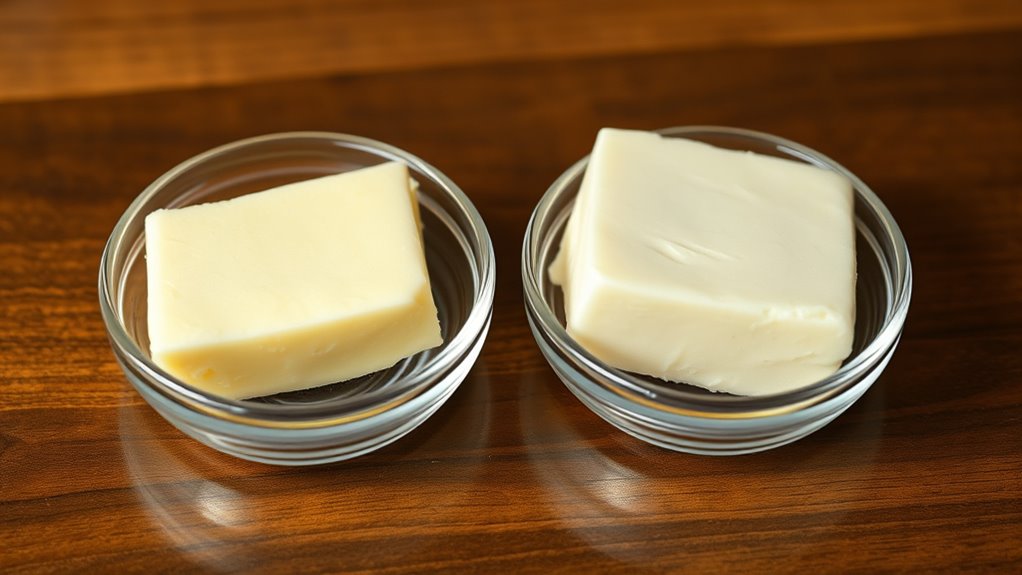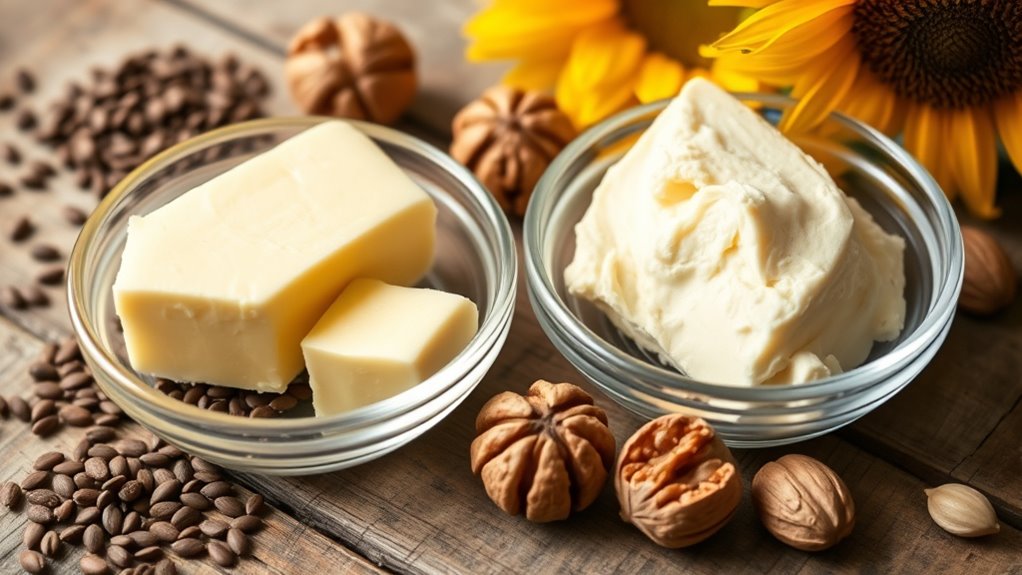When comparing butter and margarine, you’ll find butter naturally contains higher levels of omega-3 and omega-6 fats with a more balanced ratio, supporting anti-inflammatory benefits. Margarine’s omega fatty acid profile varies depending on processing, often skewing toward higher omega-6 and sometimes containing trans fats, which can impact health negatively. Understanding these differences helps you make smarter choices for your diet’s fat balance. Keep exploring to learn how these ratios affect your wellness.
Key Takeaways
- Butter naturally contains higher levels of omega-3 and omega-6 fatty acids with a relatively balanced ratio.
- Margarine’s omega-6 to omega-3 ratio varies depending on processing and formulation, often skewed toward higher omega-6 levels.
- Hydrogenation in older margarine types increases omega-6 content and may elevate the omega-6 to omega-3 ratio.
- Modern margarines generally have improved fatty acid profiles with reduced trans fats but still differ in omega-6 to omega-3 ratios.
- Maintaining a lower omega-6 to omega-3 ratio is beneficial for reducing inflammation and promoting overall health.
Understanding Omega-6 and Omega-3 Fatty Acids

Have you ever wondered why omega-6 and omega-3 fatty acids are often discussed in relation to health? These essential fats are found mainly in plant-based fats, which your body can’t produce on its own. To maintain prime health, dietary recommendations suggest balancing your intake of these fatty acids. Omega-3s, prevalent in flaxseeds, walnuts, and certain oils, support brain function and reduce inflammation. Omega-6s, common in vegetable oils and processed foods, are also crucial but should be consumed in moderation. An imbalance—too much omega-6 compared to omega-3—can promote inflammation and increase health risks. Understanding these differences helps you make smarter choices about your diet, especially when choosing between fats like butter and margarine, which vary in their fatty acid profiles. Additionally, high-quality projectors with accurate color reproduction can enhance visual clarity when viewing educational content about nutrition.
The Nutritional Profile of Butter

Butter contains a specific mix of fatty acids that impact your health, with higher saturated fat levels compared to margarine. It also provides essential vitamins like A, D, E, and K, which support your immune system and overall wellness. Understanding its nutritional profile helps you make more informed choices about including butter in your diet. For example, Italian cuisine often features butter in various traditional dishes, highlighting its culinary versatility.
Fatty Acid Composition
Understanding the fatty acid composition of butter reveals why it’s often considered a rich source of specific fats. Butter contains mainly saturated fats, along with smaller amounts of monounsaturated and polyunsaturated fats. These fatty acids influence its flavor profiles, providing a rich, creamy taste that enhances many dishes. The saturated fats contribute to butter’s stable structure, making it suitable for high-temperature cooking applications like sautéing and baking. Its unique fatty acid makeup also affects mouthfeel and aroma, adding depth to baked goods and sauces. While butter’s omega‑6 to omega‑3 ratio is higher than some alternatives, its distinctive fatty acid profile makes it a versatile ingredient for flavor development and cooking techniques that benefit from its stability and richness. Additionally, collagen and hyaluronic acid found in some formulations of butter can contribute to improved skin health when consumed regularly.
Vitamin Content
Did you know that butter is a notable source of essential fat-soluble vitamins? It naturally contains vitamins A, D, E, and K, offering significant fortification benefits. These vitamins support your immune system, vision, and bone health. Butter’s vitamin stability guarantees these nutrients remain intact during storage and cooking, making it a reliable source. The table below highlights key vitamins found in butter:
| Vitamin | Content per 100g |
|---|---|
| Vitamin A | 684 µg |
| Vitamin D | 1.4 µg |
| Vitamin E | 2.3 mg |
| Vitamin K | 7.2 µg |
This nutritional profile makes butter a valuable, natural vitamin source, especially when choosing minimally processed options. Vitamin stability ensures these nutrients are preserved during various cooking methods.
The Nutritional Profile of Margarine

Margarine’s nutritional profile varies depending on its ingredients and processing methods, but it generally provides a source of fats and calories. Some types contain trans fat, which results from hydrogenation during processing and can negatively impact heart health. Many traditional margarines have higher trans fat content, although newer formulations aim to reduce or eliminate it. The processing methods used—such as hydrogenation or interesterification—significantly influence the fat composition, affecting both stability and nutritional value. Some margarines are fortified with vitamins like A and D, enhancing their nutritional benefits. Overall, while margarine offers a convenient fat source, paying attention to its trans fat levels and processing techniques helps you make healthier choices. Always check labels to understand the specific nutritional profile of your margarine. Additionally, understanding the fat composition of margarine can help you select healthier options aligned with your dietary needs.
Comparing Omega-6 to Omega-3 Ratios in Butter and Margarine

You should consider how the fatty acid profiles in butter and margarine differ, especially their omega-6 to omega-3 ratios. These ratios impact your health by influencing inflammation and heart disease risk. Understanding these differences helps you make better choices for your overall well-being. Incorporating healthy fats into your diet can support better balance and reduce health risks.
Fatty Acid Profiles
How do the fatty acid profiles of butter and margarine differ when it comes to omega-6 and omega-3 ratios? Butter naturally contains higher levels of saturated fats and a balanced mix of omega-3 and omega-6 fatty acids. Margarine, depending on its processing methods, can have varying trans fat content, especially in older or less refined versions. Modern margarines often undergo hydrogenation, increasing trans fats, which skew the fatty acid profile and raise omega-6 levels. These processing methods markedly influence the ratio, with some margarines having a much higher omega-6 to omega-3 ratio compared to butter. Understanding these differences helps you see how manufacturing impacts the fatty acid composition, affecting the overall health profile of these spreads.
Health Impact Differences
The health implications of butter and margarine largely hinge on their omega-6 to omega-3 ratios, which influence inflammation and chronic disease risk. Margarine often contains higher trans fat content, which can raise bad cholesterol levels and increase heart disease risk. However, some margarine varieties are now trans fat-free, reducing this concern. Butter’s lower omega-6 to omega-3 ratio may mean less inflammation, but its saturated fat content can still impact heart health. Your flavor preferences also matter; margarine’s neutral taste appeals to many, while butter’s rich flavor is favored by others. Ultimately, understanding these ratios helps you make informed choices aligned with your health goals, balancing trans fat intake and personal taste to support overall well-being. Nutritional composition is a key factor to consider when evaluating these fats for a balanced diet.
Health Implications of Different Ratios

The health implications of different butter-to-margarine ratios hinge on the types and amounts of fats you consume. A higher omega-6 to omega-3 ratio, common in many margarines, can promote inflammation and increase health risks if not balanced. Conversely, a balanced ratio supports better heart health and reduces inflammation. Beyond health, these ratios also influence flavor profiles and culinary versatility. Butter offers rich, creamy flavors that enhance baked goods and sauces, while margarine provides neutral notes suitable for spreading and frying. Choosing the right balance affects not only your health but also how you experience different dishes. Being mindful of these ratios helps you make informed decisions that align with your nutritional goals without sacrificing flavor or culinary flexibility. Additionally, understanding the impact of fat ratios on overall wellness can guide healthier dietary choices.
Choosing the Best Option for a Balanced Diet

When aiming for a balanced diet, choosing between butter and margarine depends on your overall nutritional goals and preferences. Your decision can also be influenced by flavor profiles and cultural preferences. To help you decide, consider these factors:
- Flavor profiles: Butter offers rich, creamy taste, ideal for baking and spreading, while margarine has a milder flavor that works well in various recipes.
- Nutritional goals: If you’re focusing on reducing omega-6 intake, opt for options with healthier fat ratios, which may influence your choice.
- Cultural preferences: Traditional dishes or regional cuisines may favor one over the other, shaping your selection based on authenticity and taste.
- Understanding dog names can inspire you to choose healthier fats that promote a balanced diet similar to selecting appropriate names for your pet.
Ultimately, choose what aligns with your dietary needs, culinary tastes, and cultural background for a balanced, satisfying diet.
Frequently Asked Questions
How Do Processing Methods Affect Omega Fatty Acid Content?
You should know that industrial processing can substantially impact omega fatty acid content. During processing, additives and heat can degrade delicate omega-3s, reducing their levels, while sometimes increasing omega-6s. This additive impact means processed oils often have altered fatty acid profiles, making them less healthy. For ideal omega balance, choose minimally processed options, as processing methods directly influence the nutritional quality of your fats.
Are There Plant-Based Margarines With Healthier Omega Ratios?
You’ll find plant-based alternatives that focus on healthier omega ratios. Look for margarines with omega-3 enrichment, as they tend to have a better balance of omega-3 to omega-6 fats. These options often use oils like flaxseed or algae, which naturally contain higher omega-3 levels. Choosing such margarine allows you to improve your fatty acid intake while enjoying plant-based spreads.
Do Organic Butters and Margarines Differ in Fatty Acid Profiles?
You’ll find that organic butters and margarines differ in fatty acid profiles due to dairy differences and organic benefits. Organic butters tend to have higher omega-3s and fewer additives, offering a richer nutrient profile. Organic margarines often contain healthier fats and are free from artificial ingredients. Choosing organic supports sustainable farming and may enhance your health by providing cleaner, more natural fats, making them a better choice for your diet.
How Do Cooking Methods Impact Omega Fatty Acids in These Fats?
When you cook with fats, your chosen cooking techniques, whether frying, baking, or sautéing, directly influence fat preservation. High heat can break down omega fatty acids, reducing their health benefits, while gentle methods like simmering help preserve them. To maximize omega-3 and omega-6 retention, opt for lower temperatures and shorter cooking times. This way, you protect the delicate fats and enjoy their nutritional benefits.
Can Omega Ratios Influence Specific Health Conditions or Diseases?
Your omega ratios can influence your health, especially regarding cardiovascular risk and inflammatory response. A higher omega-6 to omega-3 ratio may increase inflammation, raising your likelihood of heart disease. Conversely, a balanced ratio supports better cardiovascular health and reduces inflammation. By choosing fats with ideal omega ratios, you help manage these conditions, potentially lowering your disease risk and promoting overall well-being.
Conclusion
Ultimately, finding a balance in your diet’s fats can gently guide you toward better health. While butter offers a comforting taste, margarine provides a more favorable omega-6 to omega-3 ratio. By mindfully choosing your spreads and enjoying them in moderation, you can subtly nurture your well-being without sacrificing flavor. Remember, a little awareness goes a long way in creating a nourishing, enjoyable eating experience—making your journey toward balance both pleasant and rewarding.









